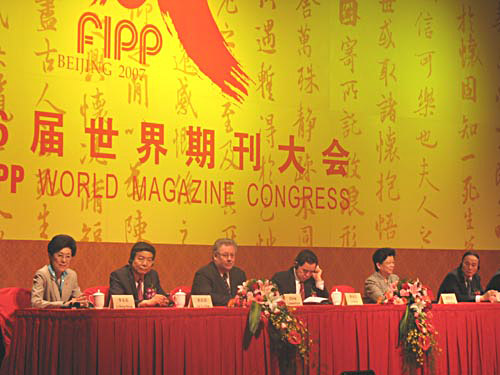
The 36th International Federation of the Periodical Press (FIPP) World Magazine Congress opened on May 14 in the China World Hotel. The congress was co-sponsored by the General Administration of Press and Publication, Beijing Municipal Government, and International Federation of the Periodical Press.
More than a thousand elites of the magazine publishing industry from 45 countries and regions gathered together to research the development trends of the world's magazine industry and discuss the challenges and opportunities they're facing.
Wang Qishan, mayor of Beijing, warmly welcomed the Congress on behalf of the Beijing government in the opening ceremony. China is the second Asian country to host this biannual international event, following Japan where it was held in 1997.
State Councilor Chen Zhili delivered the opening speech introducing the current status of the Chinese magazine industry. She expressed her hope that the Congress could forge a friendship between Chinese magazines and their counterparts and eventually foster the further development and diversity of the world publishing industry.
Donald D. Kummerfeld, president and CEO of FIPP, illustrated the challenges facing the magazine industry in his welcoming speech: "This Congress is taking place in what we call a global transformation period. I believe print will remain an important part of our future and perhaps the most important part for many. But we are now being offered a great opportunity to reach a greater audience – far greater than we could reach with print alone. This is exciting and frightening at the same time."
Liu Binjie, minister of General Administration of Press and Publication (GAPP), delivered a keynote speech at the opening ceremony. He said the Congress provides a platform for world periodicals to seek communication and cooperation, as well as a good chance for the world magazine industry to better understand China.
He also introduced the reform and development history of Chinese magazines, the policy on the joint-venture program between Chinese magazines and foreign companies, and the cultural outlook and values of Chinese magazines.
According to the organizational committee, the theme of the 36th FIPP World Magazine Congress is "magazines enrich your world," and the topics for discussion center around hot issues such as: "the development strategy for digital publication of traditional magazines," "the strategic layout for highly efficient distribution of magazines," "the magazine markets of developing countries," and "changes in the reading tastes and reading habits of magazine readers."
The China Periodicals Association joined the FIPP in October 2000. Founded in 1925, the International Federation of the Periodical Press is the most representative and influential international organization in this industry, and its members include the world's leading magazine publishers as well as national and regional organizations. At present, about 200,000 magazine titles are published worldwide.
The statistics from the General Administration of Press and Publication show that in China, 9,386 titles of magazines were published in 2006, 2.85 billion copies of magazines and 13.47 billion sheets were printed, and the total of fixed prices was 14 billion yuan in addition to revenues from advertisements, conferences, and exhibitions.
The large-scale economic implications of these statistics show how China's magazine industry has developed into an important cultural undertaking and industrial form that can provide ideological and media guidance, disseminate cultural information, and gather social resources.
According to the Development Program of the Press and Publication Industry for the 2006-2010 period, 3.1 billion copies of magazines and 12 billion sheets will be printed and per capita magazine consumption will reach 2.5 copies by 2010.
(China.org.cn, May 15, 2007) | 